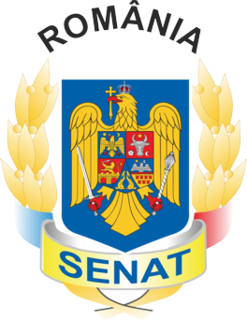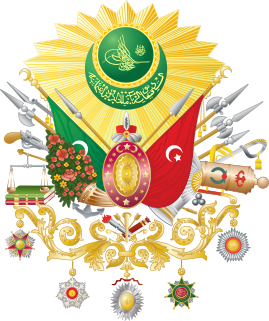
The Turkish War of Independence was a series of military campaigns waged by the Turkish National Movement after parts of the Ottoman Empire were occupied and partitioned following its defeat in World War I. The campaigns were directed against Greece in the west, Armenia in the east, France in the south, monarchists and separatists in various cities, and Britain and Italy in Constantinople. Simultaneously, the Turkish nationalist movement carried out massacres and deportations in order to eliminate native Christian populations—a continuation of the Armenian genocide and other ethnic cleansing operations during World War I. These campaigns resulted in the creation of the Republic of Turkey.

The Grand National Assembly of Turkey, usually referred to simply as the TBMM or Parliament, is the unicameral Turkish legislature. It is the sole body given the legislative prerogatives by the Turkish Constitution. It was founded in Ankara on 23 April 1920 in the midst of the National Campaign. This constitution had founded its pre-government known as 1st Executive Ministers of Turkey in May 1920. The parliament was fundamental in the efforts of Mareşal Mustafa Kemal Atatürk, 1st President of the Republic of Turkey, and his colleagues to found a new state out of the remnants of the Ottoman Empire.

The Riigikogu is the unicameral parliament of Estonia. All important state-related questions pass through the Riigikogu. In addition to approving legislation, the Riigikogu appoints high officials, including the Prime Minister and Chief Justice of the Supreme Court, and elects the President. The Riigikogu also ratifies significant foreign treaties that impose military and proprietary obligations, bring about changes in the law, etc.; approves the budget presented by the government as law and monitors the executive power.

The Senate is the upper house in the bicameral Parliament of Romania. It has 136 seats, to which members are elected by direct popular vote using party-list proportional representation in 43 electoral districts, to serve four-year terms.

The Second Constitutional Era was the period of restored parliamentary rule in the Ottoman Empire between the 1908 Young Turk Revolution and the 1920 dissolution of the General Assembly, during the empire's twilight years.

The Turkish National Movement encompasses the political and military activities of the Turkish revolutionaries that resulted in the creation and shaping of the modern Republic of Turkey, as a consequence of the defeat of the Ottoman Empire in World War I and the subsequent occupation of Constantinople and partitioning of the Ottoman Empire by the Allies under the terms of the Armistice of Mudros. The Ottomans saw the movement as part of an international conspiracy against them. The Turkish revolutionaries rebelled against this partitioning and against the Treaty of Sèvres, signed in 1920 by the Ottoman government, which partitioned portions of Anatolia itself.

Ahmed Muhtar Pasha was a prominent Ottoman field marshal and Grand Vizier, who served in the Crimean and Russo-Turkish wars. Ahmed Muhtar Pasha was appointed as Grand Vizier in July 1912 at age 72, largely due to his prestige as an old military hero.

The First Constitutional Era of the Ottoman Empire was the period of constitutional monarchy from the promulgation of the Ottoman constitution of 1876, written by members of the Young Ottomans, that began on 23 December 1876 and lasted until 14 February 1878. These Young Ottomans were dissatisfied by the Tanzimat and instead pushed for a constitutional government similar to that in Europe. The constitutional period started with the dethroning of Sultan Abdulaziz. Abdul Hamid II took his place as Sultan. The era ended with the suspension of the Ottoman Parliament and the constitution by Sultan Abdul Hamid II, with which he restored his own absolute monarchy.

Starting in the 19th century the Ottoman Empire's governing structure slowly transitioned and standardized itself into a Western style system of government, sometimes known as the Imperial Government. Mahmud II initiated this process following the disbandment and massacre of the Janissary corps, at this point a conservative bureaucratic elite, in the Auspicious Incident. A long period of reform known as the Tanzimat period started, which yielded much needed reform to the government and social contract with the multicultural citizens of the empire.

The Sivas Congress was an assembly of the Turkish National Movement held for one week from 4 to 11 September 1919 in the city of Sivas, in central-eastern Turkey, which united delegates from all Anatolian provinces of the Ottoman Empire, defunct at the time in practical terms. At the time of the convention, the state capital (Constantinople) as well as many provincial cities and regions were under occupation by the Allied powers preparing for the partition of the Ottoman Empire. This was part of the wider conflict of the Turkish War of Independence.

The occupation of Constantinople, the capital of the Ottoman Empire, by British, French, Italian, and Greek forces, took place in accordance with the Armistice of Mudros, which ended Ottoman participation in the First World War. The first French troops entered the city on November 12, 1918, followed by British troops the next day. The Italian troops landed in Galata on February 7, 1919.

Bekir Sami Bey was a Turkish politician of Ossetian origin. He served as the first Minister of Foreign Affairs of Turkey during 1920–1921.

The 1877 general election to the Chamber of Deputies of the Third Republic was held on 14 and 28 October 1877, during the Seize Mai crisis.

Senate of the Republic was the upper house of Turkish Parliament between 1961 and 1980. It was established with the Turkish constitution of 1961 and abolished with the 1982 constitution, although it did not exist after 12 September 1980 as a result of the 1980 coup d'état.

The General Assembly was the first attempt at representative democracy by the imperial government of the Ottoman Empire. Also known as the Ottoman Parliament, it was located in Constantinople (Istanbul) and was composed of two houses: an upper house, and a lower house.

The Chamber of Deputies of the Ottoman Empire was the lower house of the General Assembly, the Ottoman Parliament. Unlike the upper house, the Senate, the members of the Chamber of Deputies were elected by the general Ottoman populace, although suffrage was limited to males of a certain financial standing, among other restrictions that varied over the Chamber's lifetime.
General elections were held in the Ottoman Empire in 1919 and were the last official elections held in the Empire. Due to the dearth of political parties, the elections were dominated by the Association for the Defense of the Rights of Anatolia and Rumelia, which consisted of nationalist local groups protesting against the Allied occupation of Turkey.
General elections were held in the Ottoman Empire in 1920 in order to select delegates to the new Grand National Assembly. The elections were dominated by the Association for the Defense of the Rights of Anatolia and Rumelia, which consisted of nationalist local groups protesting against the Allied occupation of Turkey.
The Senate of the Ottoman Empire was the upper house of the parliament of the Ottoman Empire, the General Assembly. Its members were appointed notables in the Ottoman government who, along with the elected lower house Chamber of Deputies, made up the General Assembly. It was created in its first incarnation according to the Ottoman constitution of 1876, which sought to reform the Ottoman Empire into a constitutional monarchy.

In Czechoslovakia the first parliamentary elections to the National Assembly were held in 1920, two years after the country came into existence. They followed the adoption of the 1920 constitution. Prior to the elections, a legislature had been formed under the name Revolutionary National Assembly, composed of the Czech deputies elected in 1911 in Cisleithania, Slovak deputies elected in Hungary in 1910 and other co-opted deputies.












